run flat HONDA ACCORD HYBRID 2014 9.G Owners Manual
[x] Cancel search | Manufacturer: HONDA, Model Year: 2014, Model line: ACCORD HYBRID, Model: HONDA ACCORD HYBRID 2014 9.GPages: 561, PDF Size: 20.3 MB
Page 27 of 561

26
Quick Reference Guide
Handling the Unexpected (P 509)
Flat Tire (P 510)
● Park in a safe location and repair the flat
tire using the tire repair kit in the trunk.
Indicators Come On
(P 528) ● Identify the indicator and consult the
owner's manual.
Power System Won't Start (P 519)
● If the 12-volt battery is dead, jump start
using a booster battery.
Blown Fuse (P 532)
● Check for a blown fuse if an electrical
device does not operate.Overheating (P 525)
● Park in a safe location. If you do not see
steam under the hood, open the hood,
and let the power system cool down.
Emergency Towing
(P 535) ● Call a professional towing service if you
need to tow your vehicle.
Main Menu
Page 163 of 561
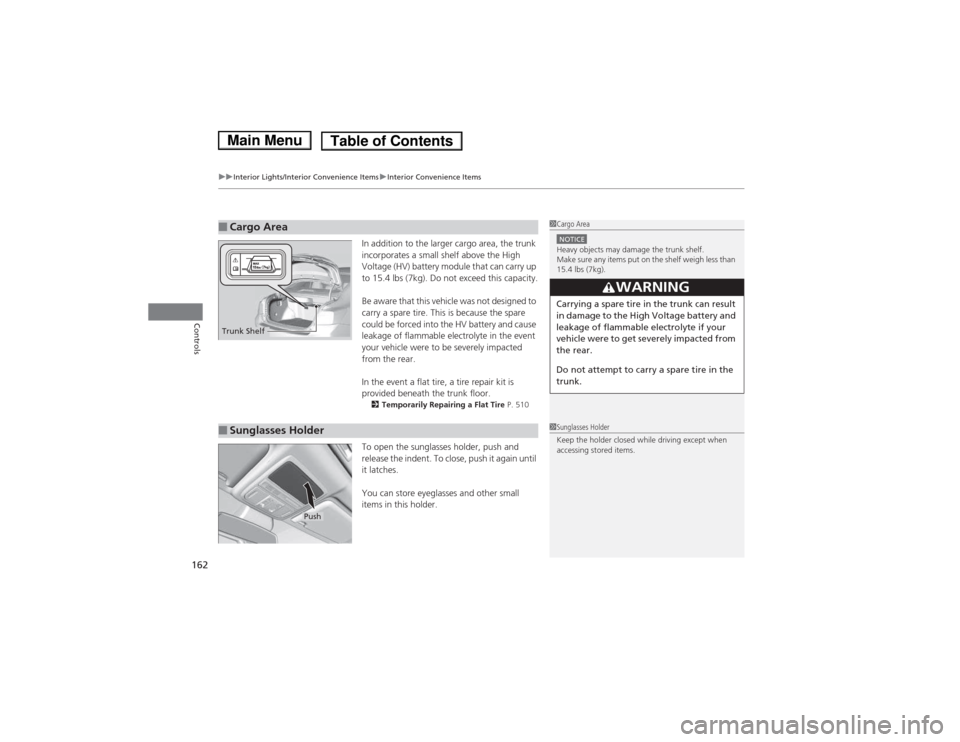
uuInterior Lights/Interior Convenience ItemsuInterior Convenience Items
162
Controls
In addition to the larger cargo area, the trunk
incorporates a small shelf above the High
Voltage (HV) battery module that can carry up
to 15.4 lbs (7kg). Do not exceed this capacity.
Be aware that this vehicle was not designed to
carry a spare tire. This is because the spare
could be forced into the HV battery and cause
leakage of flammable electrolyte in the event
your vehicle were to be severely impacted
from the rear.
In the event a flat tire, a tire repair kit is
provided beneath the trunk floor. 2 Temporarily Repairing a Flat Tire P. 510
To open the sunglasses holder, push and
release the indent. To close, push it again until
it latches.
You can store eyeglasses and other small
items in this holder.
■Cargo Area1Cargo Area
NOTICEHeavy objects may damage the trunk shelf.
Make sure any items put on the shelf weigh less than
15.4 lbs (7kg).
3WARNING
Carrying a spare tire in the trunk can result
in damage to the High Voltage battery and
leakage of flammable electrolyte if your
vehicle were to get severely impacted from
the rear.
Do not attempt to carry a spare tire in the
trunk.
Trunk Shelf
■Sunglasses Holder1Sunglasses Holder
Keep the holder closed while driving except when
accessing stored items.
Push
Main MenuTable of Contents
Page 439 of 561
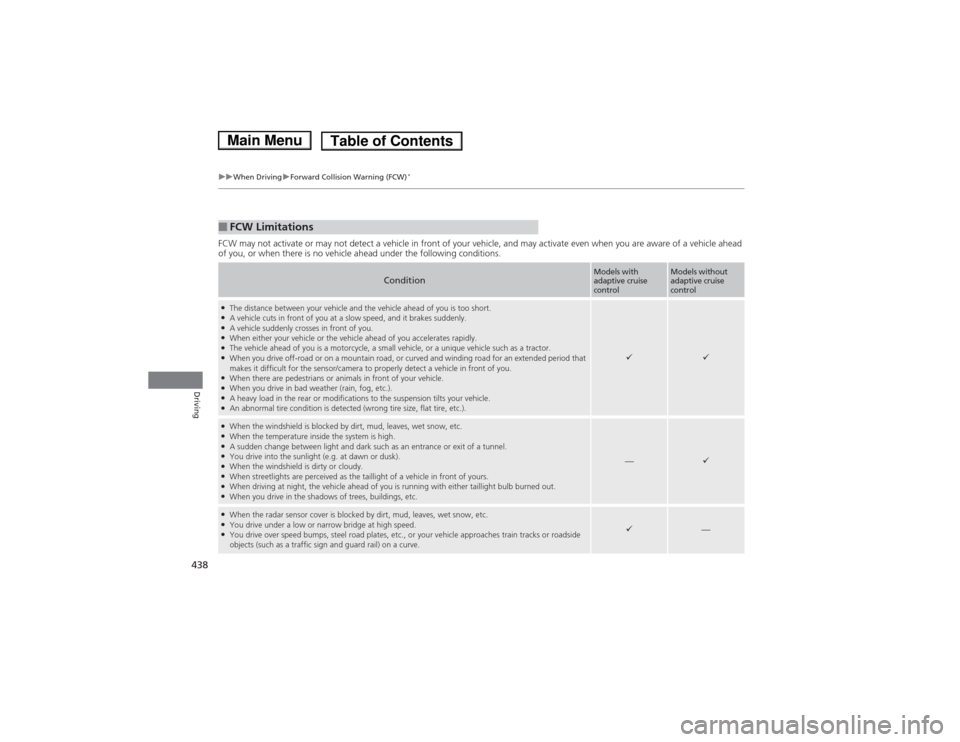
438
uuWhen DrivinguForward Collision Warning (FCW)*
Driving
FCW may not activate or may not detect a vehicle in front of your vehicle, and may activate even when you are aware of a vehicl
e ahead
of you, or when there is no vehicle ahead under the following conditions.
■FCW Limitations
ConditionModels with adaptive cruise
controlModels without adaptive cruise
control
● The distance between your vehicle and the vehicle ahead of you is too short.
● A vehicle cuts in front of you at a slow speed, and it brakes suddenly.
● A vehicle suddenly crosses in front of you.
● When either your vehicle or the vehicle ahead of you accelerates rapidly.
● The vehicle ahead of you is a motorcycle, a small vehicle, or a unique vehicle such as a tractor.
● When you drive off-road or on a mountain road, or curved and winding road for an extended period that
makes it difficult for the sensor/camera to properly detect a vehicle in front of you.
● When there are pedestrians or animals in front of your vehicle.
● When you drive in bad weather (rain, fog, etc.).
● A heavy load in the rear or modifications to the suspension tilts your vehicle.
● An abnormal tire condition is detected (wrong tire size, flat tire, etc.).
��
●
When the windshield is blocked by dirt, mud, leaves, wet snow, etc.
● When the temperature inside the system is high.
● A sudden change between light and dark such as an entrance or exit of a tunnel.
● You drive into the sunlight (e.g. at dawn or dusk).
● When the windshield is dirty or cloudy.
● When streetlights are perceived as the taillight of a vehicle in front of yours.
● When driving at night, the vehicle ahead of you is running with either taillight bulb burned out.
● When you drive in the shadows of trees, buildings, etc.
—�
●When the radar sensor cover is blocked by dirt, mud, leaves, wet snow, etc.
● You drive under a low or narrow bridge at high speed.
● You drive over speed bumps, steel road plates, etc., or your vehicle approaches train tracks or roadside
objects (such as a traffic sign and guard rail) on a curve.
�—
Main MenuTable of Contents
Page 443 of 561
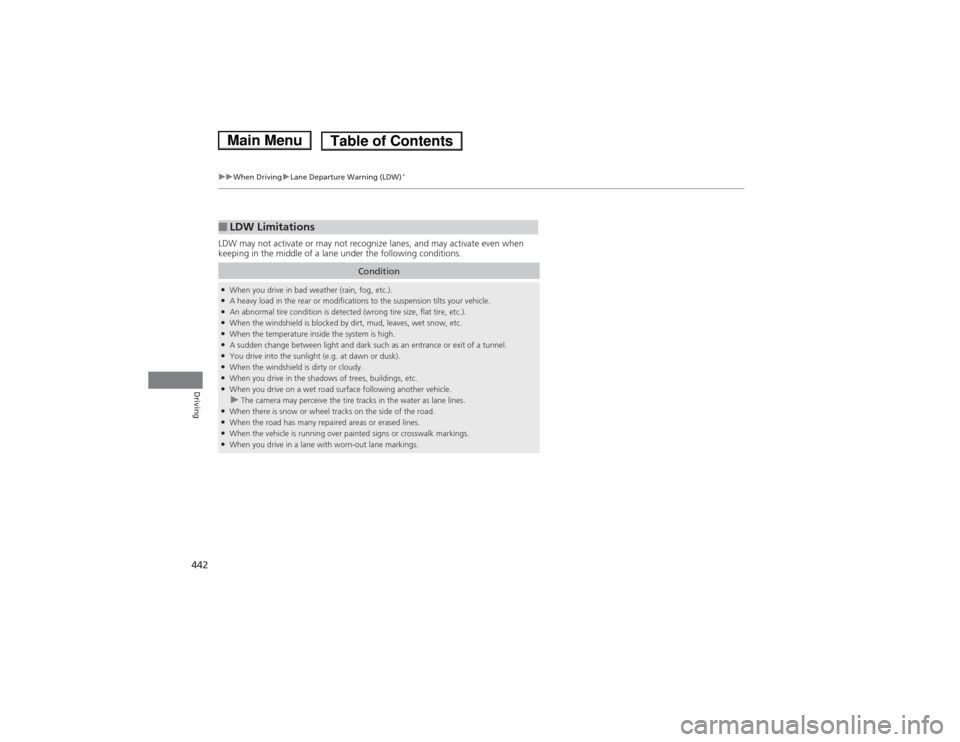
442
uuWhen DrivinguLane Departure Warning (LDW)*
Driving
LDW may not activate or may not recognize lanes, and may activate even when
keeping in the middle of a lane under the following conditions.
■LDW Limitations
Condition
●
When you drive in bad weather (rain, fog, etc.).
● A heavy load in the rear or modifications to the suspension tilts your vehicle.
● An abnormal tire condition is detected (wrong tire size, flat tire, etc.).
● When the windshield is blocked by dirt, mud, leaves, wet snow, etc.
● When the temperature inside the system is high.
● A sudden change between light and dark such as an entrance or exit of a tunnel.
● You drive into the sunlight (e.g. at dawn or dusk).
● When the windshield is dirty or cloudy.
● When you drive in the shadows of trees, buildings, etc.
● When you drive on a wet road surface following another vehicle.
uThe camera may perceive the tire tracks in the water as lane lines.
● When there is snow or wheel tracks on the side of the road.
● When the road has many repaired areas or erased lines.
● When the vehicle is running over painted signs or crosswalk markings.
● When you drive in a lane with worn-out lane markings.
Main MenuTable of Contents
Page 512 of 561

Continued511
uuIf a Tire Goes FlatuTemporarily Repairing a Flat Tire
Handling the Unexpected
1.Open the trunk floor lid.
2. Open the fastener and take the kit out of the case.
3. Place the kit face up, on flat ground near
the flat tire, and away from traffic. Do not
place the kit on its side.
■Getting Ready to Temporarily Repair the Flat Tire1Getting Ready to Temporarily Repair the Flat Tire
When making a temporary repair, carefully read the
instruction manual provided with the kit.
In cold temperatures, the sealant may not flow easily.
In this situation, warm it up for five minutes before using.
Instruction
Manual
Air Only Hose (Black) Speed Restriction Label
Repair Notification Label
Pressure Relief
Button Inflator Switch
Selector Switch
SEALANT/AIR side
Sealant/Air Hose (Clear)
AIR ONLY side
Power Plug
Pressure Gauge
Tire Sealant
Expiration Date
Fastener
Trunk Floor Lid
Tire Repair Kit
Main MenuTable of Contents
Page 514 of 561

Continued513
uuIf a Tire Goes FlatuTemporarily Repairing a Flat Tire
Handling the Unexpected
4.Plug in the compressor to the accessory power socket.
uBe careful not to pinch the cord in a
door or window.
5. Turn the power system on.
uKeep the power system on while
injecting sealant and air.
2 Carbon Monoxide Gas P. 68
6. Turn the selector switch to SEALANT/
AIR .
7. Press the inflator switch to turn on the
compressor.
uThe compressor starts injecting sealant
and air into the tire.
8. When the sealant injection is complete,
continue to add air.
9. After the air pressure reaches front: 33 psi
(230kPa)/rear: 33 psi (225 kPa), turn off
the kit.
uTo check the pressure, occasionally turn
off the compressor and read the gauge.
1Injecting Sealant and Air
NOTICEDo not operate the tire repair kit compressor for
more than 15 minutes. The accessory power socket
and compressor can overheat and become permanently damaged.
Until the sealant injection is complete, the pressure
shown on the pressure gauge will appear higher than
actual. After the sealant injection is complete the
pressure will drop and then begin to rise again as the
tire is inflated with air. This is normal. To accurately
measure the air pressure using the gauge, turn the air
compressor off only after the sealant injection is complete.
If the required air pressure is not reached within 10
minutes, the tire may be too severely damaged for
the kit to provide the necessary seal and your vehicle
will need to be towed.
3WARNING
Running the engine with the vehicle in an
enclosed or even partly enclosed area can cause
a rapid build-up of toxic carbon monoxide.
Breathing this colorless, odorless gas can
cause unconsciousness and even death.
Only run the engine to power the air
compressor with the vehicle outdoors.
SEALANT/AIR side
Pressure Gauge
ON
OFF
Main MenuTable of Contents
Page 516 of 561
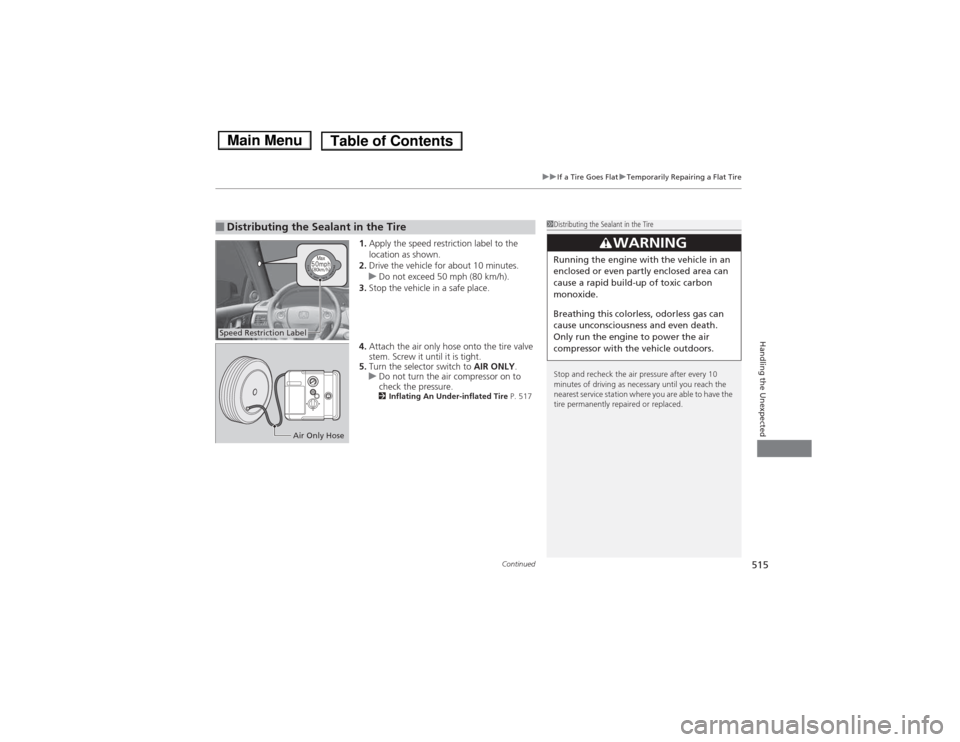
Continued515
uuIf a Tire Goes FlatuTemporarily Repairing a Flat Tire
Handling the Unexpected
1.Apply the speed restriction label to the
location as shown.
2. Drive the vehicle for about 10 minutes.
uDo not exceed 50 mph (80 km/h).
3. Stop the vehicle in a safe place.
4. Attach the air only hose onto the tire valve
stem. Screw it until it is tight.
5. Turn the selector switch to AIR ONLY.
uDo not turn the air compressor on to
check the pressure.
2 Inflating An Under-inflated Tire P. 517
■Distributing the Sealant in the Tire1Distributing the Sealant in the Tire
Stop and recheck the air pressure after every 10
minutes of driving as necessary until you reach the
nearest service station where you are able to have the
tire permanently repaired or replaced.
3WARNING
Running the engine with the vehicle in an
enclosed or even partly enclosed area can
cause a rapid build-up of toxic carbon monoxide.
Breathing this colorless, odorless gas can
cause unconsciousness and even death.
Only run the engine to power the air
compressor with the vehicle outdoors.
Speed Restriction Label
Air Only Hose
Main MenuTable of Contents
Page 518 of 561

Continued517
uuIf a Tire Goes FlatuTemporarily Repairing a Flat Tire
Handling the Unexpected
You can use the kit to inflate a non-punctured under-inflated tire.
1.Open the trunk floor lid.
2 Getting Ready to Temporarily Repair
the Flat Tire P. 511
2. Remove the kit from the case.
uPlace the kit on flat ground near the tire
to be inflated, away from traffic.
3. Place the kit, face up, on flat ground near
the flat tire, away from traffic. Do not
place the kit on its side.
4. Remove the air only hose from the kit.
5. Remove the valve cap.
6. Attach the air only hose onto the tire valve
stem. Screw it until it is tight.
■Inflating An Under-inflated Tire1Inflating An Under-inflated Tire
NOTICEDo not operate the temporary tire repair kit
compressor for more than 15 minutes. The accessory
power socket and compressor can overheat and become permanently damaged.
Air Only Hose
Valve Cap
Valve Stem
Air Only Hose
Main MenuTable of Contents
Page 519 of 561

uuIf a Tire Goes FlatuTemporarily Repairing a Flat Tire
518
Handling the Unexpected
7. Plug in the kit to the accessory power socket.
uBe careful not to pinch the cord in a
door or window.
8. Turn the power system on.
uKeep the power system on while
injecting sealant and air.
2 Carbon Monoxide Gas P. 68
9. Turn the selector switch to AIR ONLY.
10. Press the inflator switch to turn on the kit.
uThe compressor starts to inject air into
the tire.
11. Inflate the tire to the specified air pressure.
12. Turn off the kit.
uCheck the pressure gauge on the air
compressor.
uIf overinflated, press the pressure relief button.
13. Unplug the kit from the accessory power socket.
14. Unscrew the air only hose from the tire
valve stem. Reinstall the valve cap.
15. Press the pressure relief button until the
gauge returns 0 psi (0 kPa).
16. Repackage and properly stow the kit.
1Inflating An Under-inflated Tire
3WARNING
Running the engine with the vehicle in an
enclosed or even partly enclosed area can
cause a rapid build-up of toxic carbon monoxide.
Breathing this colorless, odorless gas can
cause unconsciousness and even death.
Only run the engine to power the air
compressor with the vehicle outdoors.
AIR ONLY
side
ON
Pressure Relief Button
Main MenuTable of Contents
Page 555 of 561
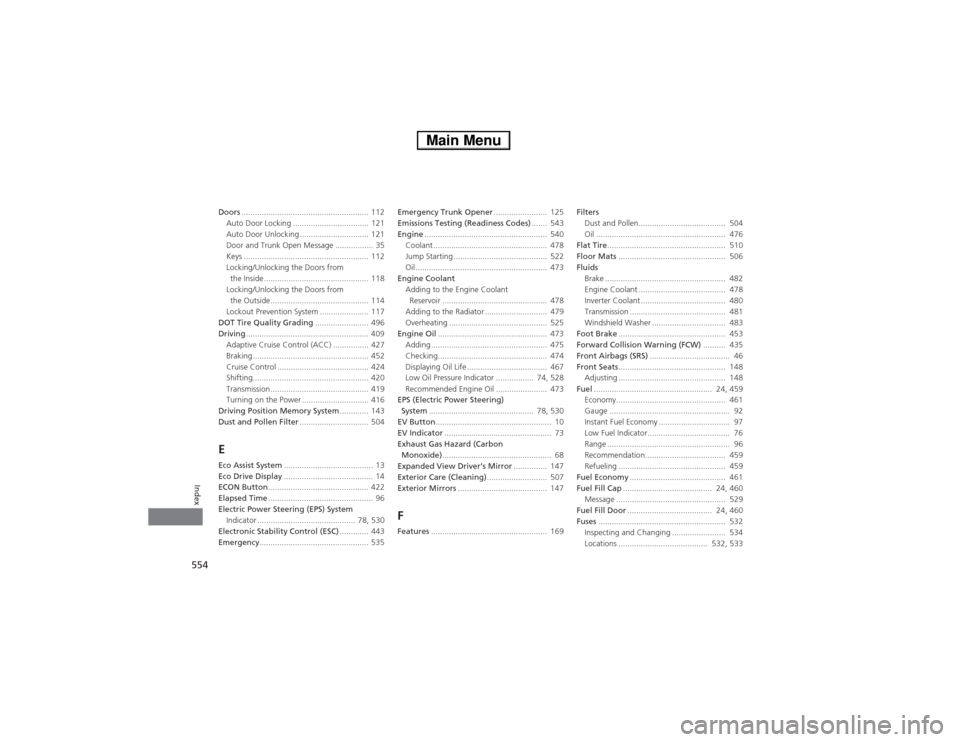
554
Index
Doors......................................................... 112
Auto Door Locking .................................. 121
Auto Door Unlocking ............................... 121
Door and Trunk Open Message ................. 35
Keys ........................................................ 112
Locking/Unlocking the Doors from the Inside ............................................... 118
Locking/Unlocking the Doors from the Outside ............................................ 114
Lockout Prevention System ...................... 117
DOT Tire Quality Grading ........................ 496
Driving ....................................................... 409
Adaptive Cruise Control (ACC) ................ 427
Braking .................................................... 452
Cruise Control ......................................... 424
Shifting.................................................... 420
Transmission ............................................ 419
Turning on the Power .............................. 416
Driving Position Memory System ............. 143
Dust and Pollen Filter ............................... 504
E
Eco Assist System ........................................ 13
Eco Drive Display ........................................ 14
ECON Button ............................................. 422
Elapsed Time ............................................... 96
Electric Power Steering (EPS) System Indicator ............................................ 78, 530
Electronic Stability Control (ESC) ............. 443
Emergency ................................................. 535 Emergency Trunk Opener
........................ 125
Emissions Testing (Readiness Codes) ....... 543
Engine ....................................................... 540
Coolant ................................................... 478
Jump Starting .......................................... 522
Oil ........................................................... 473
Engine Coolant
Adding to the Engine Coolant Reservoir ............................................... 478
Adding to the Radiator ......... ............... .... 479
Overheating ............................................ 525
Engine Oil ................................................. 473
Adding .................................................... 475
Checking................................................. 474
Displaying Oil Life .................................... 467
Low Oil Pressure Indicator ................. 74, 528
Recommended Engine Oil ....................... 473
EPS (Electric Power Steering)
System ............................................... 78, 530
EV Button .................................................... 10
EV Indicator ................................................ 73
Exhaust Gas Hazard (Carbon
Monoxide) ................................................. 68
Expanded View Driver’s Mirror ............... 147
Exterior Care (Cleaning) ........................... 507
Exterior Mirrors ........................................ 147
F
Features .................................................... 169 Filters
Dust and Pollen....................................... 504
Oil .......................................................... 476
Flat Tire ..................................................... 510
Floor Mats ................................................ 506
Fluids Brake ...................................................... 482
Engine Coolant ....................................... 478
Inverter Coolant ...................................... 480
Transmission ........................................... 481
Windshield Washer ................................. 483
Foot Brake ................................................ 453
Forward Collision Warning (FCW) .......... 435
Front Airbags (SRS) .................................... 46
Front Seats ................................................ 148
Adjusting ................................................ 148
Fuel ..................................................... 24, 459
Economy................................................. 461
Gauge ...................................................... 92
Instant Fuel Economy ................................ 97
Low Fuel Indicator..................................... 76
Range ....................................................... 96
Recommendation.................................... 459
Refueling ................................................ 459
Fuel Economy ........................................... 461
Fuel Fill Cap ........................................ 24, 460
Message ................................................. 529
Fuel Fill Door ...................................... 24, 460
Fuses ......................................................... 532
Inspecting and Changing ........................ 534
Locations ........................................ 532, 533
Main Menu